Evaluating Pitching and Negotiation Skills in Business: A Report
VerifiedAdded on 2020/12/09
|13
|3867
|451
Report
AI Summary
This report provides a comprehensive analysis of pitching and negotiation skills, focusing on their critical role in business decision-making and stakeholder management. It examines the negotiation process, including preparation, opening, bargaining, and closure phases, with a specific emphasis on Marks and Spencer's practices. The report delves into the Request for Proposal (RFP) process, elements of breaching agreements, and competitive tendering. Furthermore, it evaluates the pitch process, exploring strategies to maximize its effectiveness, such as value creation, brand loyalty, innovation, networking, and partnerships. The report also assesses potential pitch outcomes and how organizations fulfill their obligations, identifying potential issues that may arise. This analysis offers valuable insights into the practical application of these skills in a business environment.
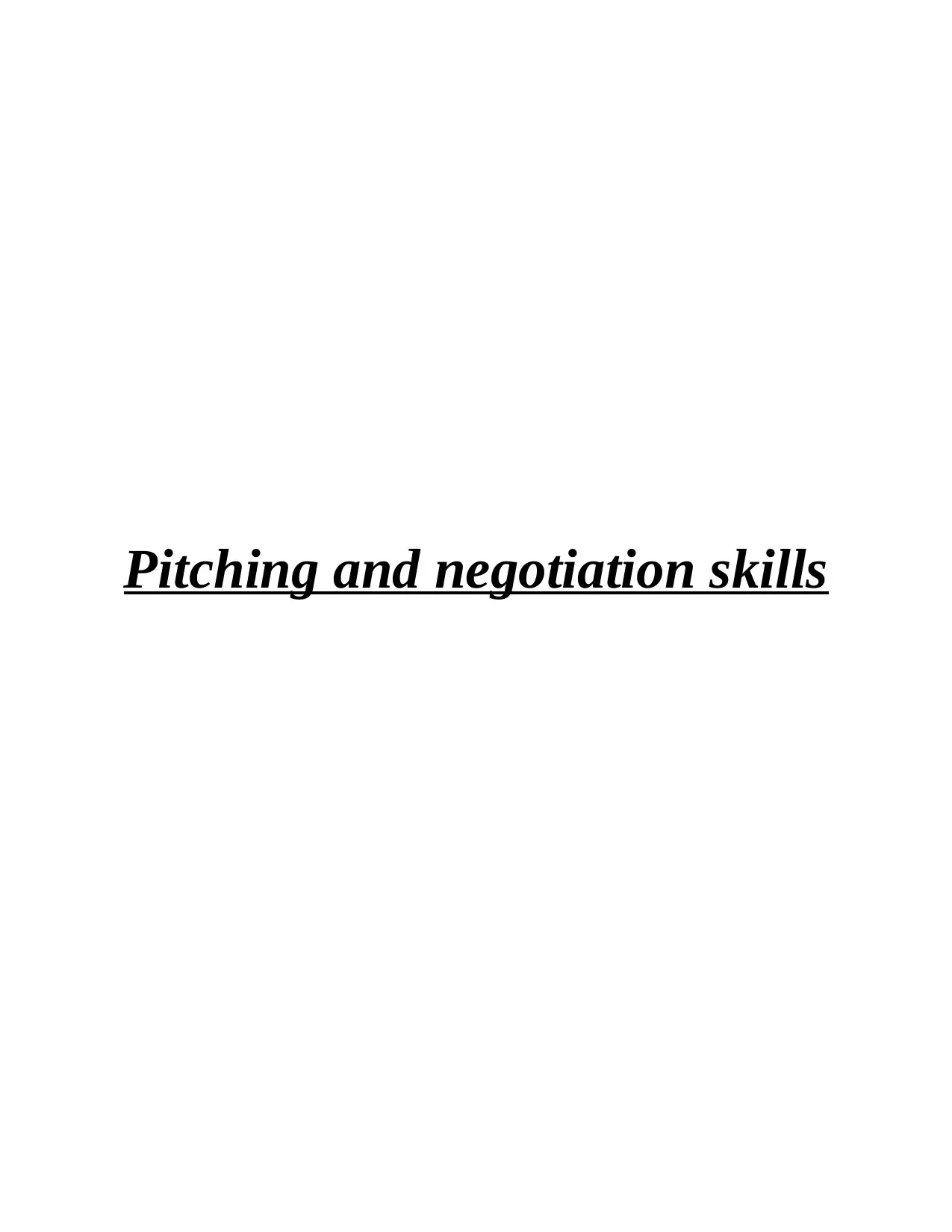
Pitching and negotiation skills
Paraphrase This Document
Need a fresh take? Get an instant paraphrase of this document with our AI Paraphraser
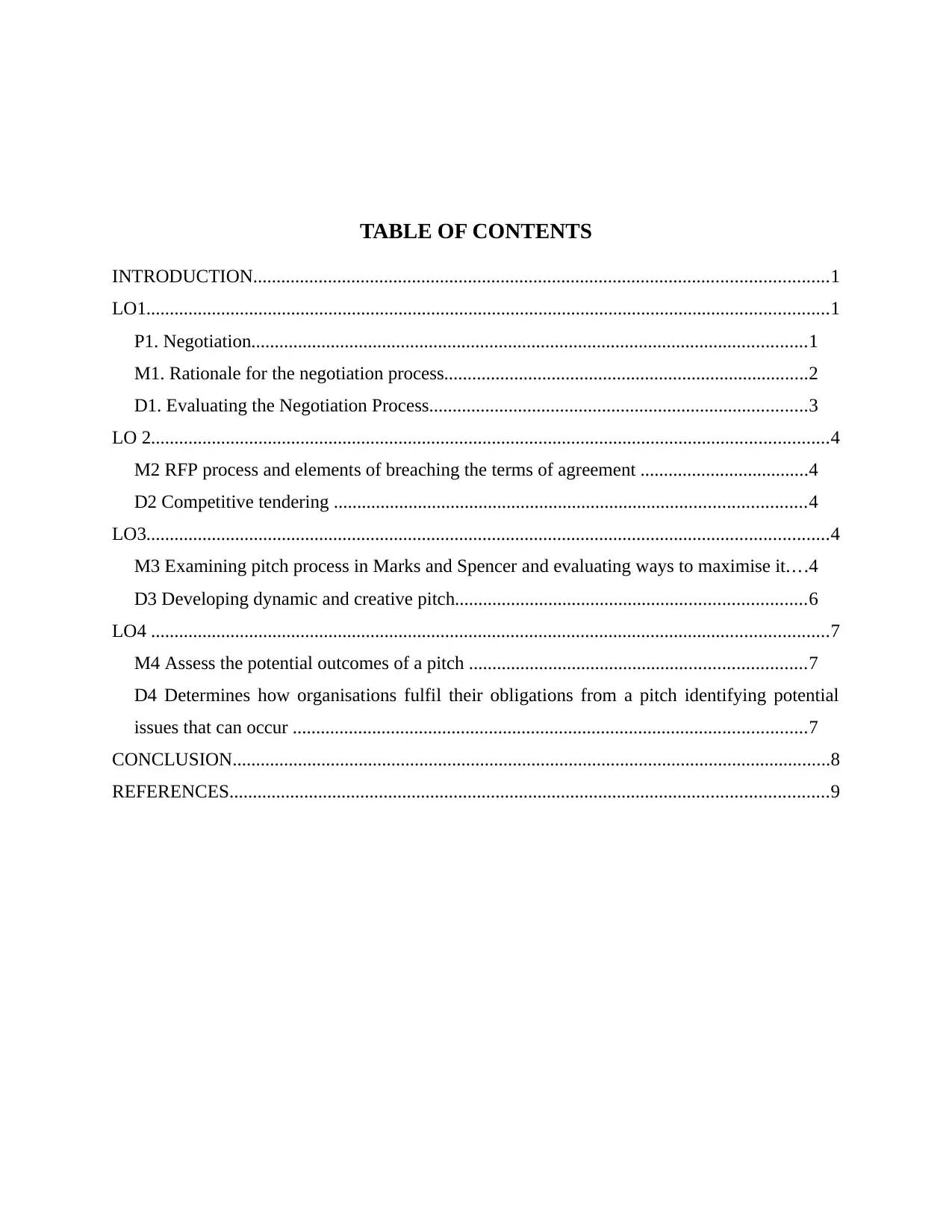
TABLE OF CONTENTS
INTRODUCTION...........................................................................................................................1
LO1..................................................................................................................................................1
P1. Negotiation.......................................................................................................................1
M1. Rationale for the negotiation process..............................................................................2
D1. Evaluating the Negotiation Process.................................................................................3
LO 2.................................................................................................................................................4
M2 RFP process and elements of breaching the terms of agreement ....................................4
D2 Competitive tendering .....................................................................................................4
LO3..................................................................................................................................................4
M3 Examining pitch process in Marks and Spencer and evaluating ways to maximise it....4
D3 Developing dynamic and creative pitch...........................................................................6
LO4 .................................................................................................................................................7
M4 Assess the potential outcomes of a pitch ........................................................................7
D4 Determines how organisations fulfil their obligations from a pitch identifying potential
issues that can occur ..............................................................................................................7
CONCLUSION................................................................................................................................8
REFERENCES................................................................................................................................9
INTRODUCTION...........................................................................................................................1
LO1..................................................................................................................................................1
P1. Negotiation.......................................................................................................................1
M1. Rationale for the negotiation process..............................................................................2
D1. Evaluating the Negotiation Process.................................................................................3
LO 2.................................................................................................................................................4
M2 RFP process and elements of breaching the terms of agreement ....................................4
D2 Competitive tendering .....................................................................................................4
LO3..................................................................................................................................................4
M3 Examining pitch process in Marks and Spencer and evaluating ways to maximise it....4
D3 Developing dynamic and creative pitch...........................................................................6
LO4 .................................................................................................................................................7
M4 Assess the potential outcomes of a pitch ........................................................................7
D4 Determines how organisations fulfil their obligations from a pitch identifying potential
issues that can occur ..............................................................................................................7
CONCLUSION................................................................................................................................8
REFERENCES................................................................................................................................9

⊘ This is a preview!⊘
Do you want full access?
Subscribe today to unlock all pages.

Trusted by 1+ million students worldwide
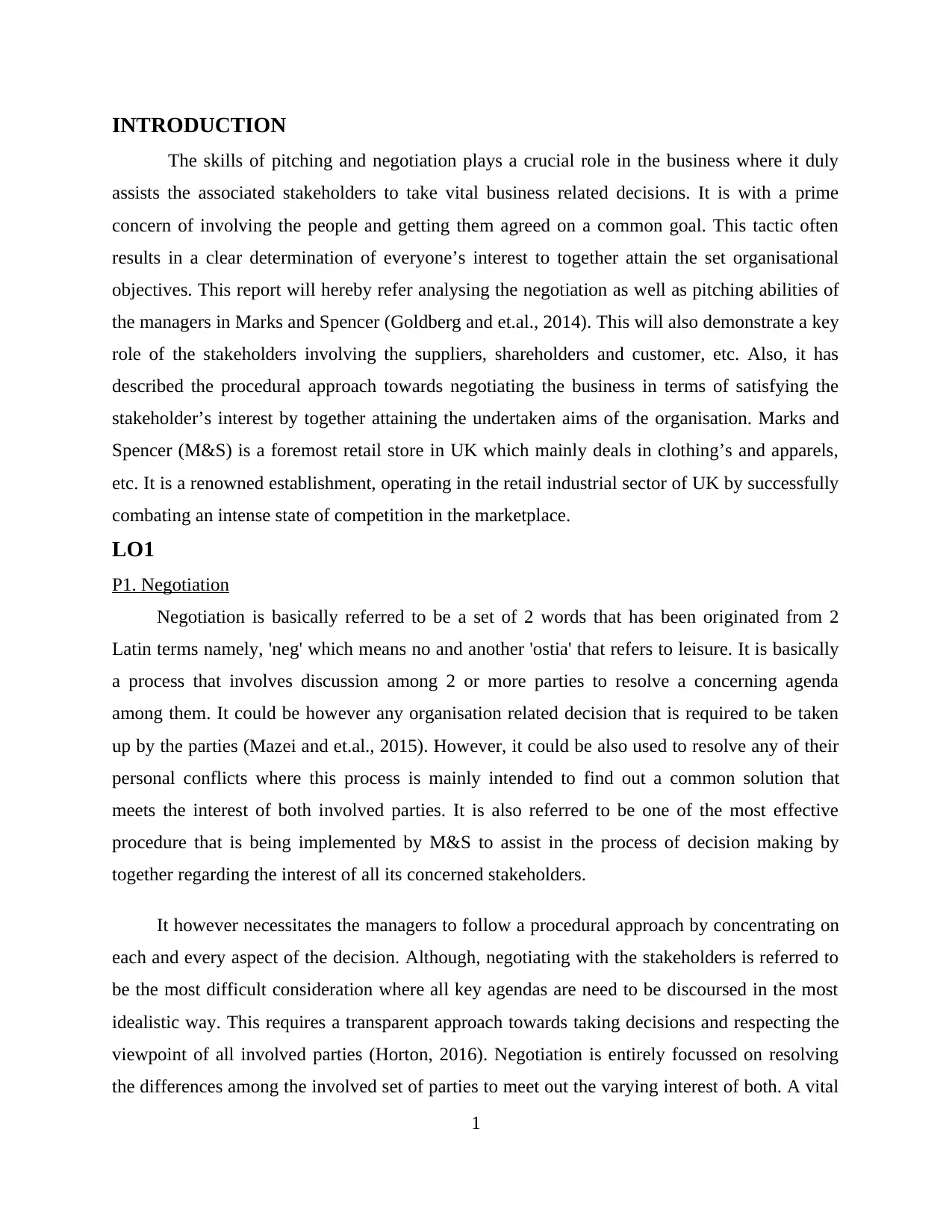
INTRODUCTION
The skills of pitching and negotiation plays a crucial role in the business where it duly
assists the associated stakeholders to take vital business related decisions. It is with a prime
concern of involving the people and getting them agreed on a common goal. This tactic often
results in a clear determination of everyone’s interest to together attain the set organisational
objectives. This report will hereby refer analysing the negotiation as well as pitching abilities of
the managers in Marks and Spencer (Goldberg and et.al., 2014). This will also demonstrate a key
role of the stakeholders involving the suppliers, shareholders and customer, etc. Also, it has
described the procedural approach towards negotiating the business in terms of satisfying the
stakeholder’s interest by together attaining the undertaken aims of the organisation. Marks and
Spencer (M&S) is a foremost retail store in UK which mainly deals in clothing’s and apparels,
etc. It is a renowned establishment, operating in the retail industrial sector of UK by successfully
combating an intense state of competition in the marketplace.
LO1
P1. Negotiation
Negotiation is basically referred to be a set of 2 words that has been originated from 2
Latin terms namely, 'neg' which means no and another 'ostia' that refers to leisure. It is basically
a process that involves discussion among 2 or more parties to resolve a concerning agenda
among them. It could be however any organisation related decision that is required to be taken
up by the parties (Mazei and et.al., 2015). However, it could be also used to resolve any of their
personal conflicts where this process is mainly intended to find out a common solution that
meets the interest of both involved parties. It is also referred to be one of the most effective
procedure that is being implemented by M&S to assist in the process of decision making by
together regarding the interest of all its concerned stakeholders.
It however necessitates the managers to follow a procedural approach by concentrating on
each and every aspect of the decision. Although, negotiating with the stakeholders is referred to
be the most difficult consideration where all key agendas are need to be discoursed in the most
idealistic way. This requires a transparent approach towards taking decisions and respecting the
viewpoint of all involved parties (Horton, 2016). Negotiation is entirely focussed on resolving
the differences among the involved set of parties to meet out the varying interest of both. A vital
1
The skills of pitching and negotiation plays a crucial role in the business where it duly
assists the associated stakeholders to take vital business related decisions. It is with a prime
concern of involving the people and getting them agreed on a common goal. This tactic often
results in a clear determination of everyone’s interest to together attain the set organisational
objectives. This report will hereby refer analysing the negotiation as well as pitching abilities of
the managers in Marks and Spencer (Goldberg and et.al., 2014). This will also demonstrate a key
role of the stakeholders involving the suppliers, shareholders and customer, etc. Also, it has
described the procedural approach towards negotiating the business in terms of satisfying the
stakeholder’s interest by together attaining the undertaken aims of the organisation. Marks and
Spencer (M&S) is a foremost retail store in UK which mainly deals in clothing’s and apparels,
etc. It is a renowned establishment, operating in the retail industrial sector of UK by successfully
combating an intense state of competition in the marketplace.
LO1
P1. Negotiation
Negotiation is basically referred to be a set of 2 words that has been originated from 2
Latin terms namely, 'neg' which means no and another 'ostia' that refers to leisure. It is basically
a process that involves discussion among 2 or more parties to resolve a concerning agenda
among them. It could be however any organisation related decision that is required to be taken
up by the parties (Mazei and et.al., 2015). However, it could be also used to resolve any of their
personal conflicts where this process is mainly intended to find out a common solution that
meets the interest of both involved parties. It is also referred to be one of the most effective
procedure that is being implemented by M&S to assist in the process of decision making by
together regarding the interest of all its concerned stakeholders.
It however necessitates the managers to follow a procedural approach by concentrating on
each and every aspect of the decision. Although, negotiating with the stakeholders is referred to
be the most difficult consideration where all key agendas are need to be discoursed in the most
idealistic way. This requires a transparent approach towards taking decisions and respecting the
viewpoint of all involved parties (Horton, 2016). Negotiation is entirely focussed on resolving
the differences among the involved set of parties to meet out the varying interest of both. A vital
1
Paraphrase This Document
Need a fresh take? Get an instant paraphrase of this document with our AI Paraphraser
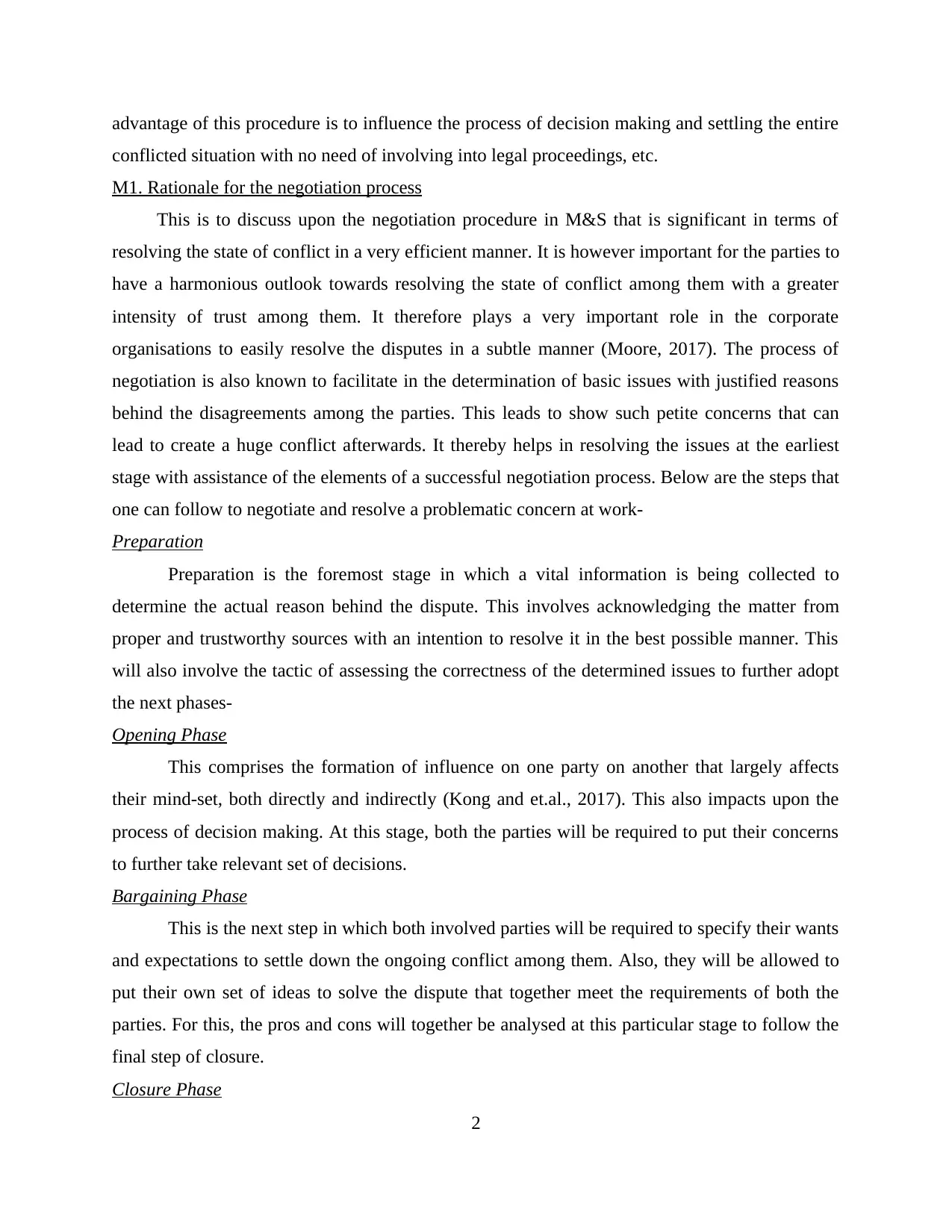
advantage of this procedure is to influence the process of decision making and settling the entire
conflicted situation with no need of involving into legal proceedings, etc.
M1. Rationale for the negotiation process
This is to discuss upon the negotiation procedure in M&S that is significant in terms of
resolving the state of conflict in a very efficient manner. It is however important for the parties to
have a harmonious outlook towards resolving the state of conflict among them with a greater
intensity of trust among them. It therefore plays a very important role in the corporate
organisations to easily resolve the disputes in a subtle manner (Moore, 2017). The process of
negotiation is also known to facilitate in the determination of basic issues with justified reasons
behind the disagreements among the parties. This leads to show such petite concerns that can
lead to create a huge conflict afterwards. It thereby helps in resolving the issues at the earliest
stage with assistance of the elements of a successful negotiation process. Below are the steps that
one can follow to negotiate and resolve a problematic concern at work-
Preparation
Preparation is the foremost stage in which a vital information is being collected to
determine the actual reason behind the dispute. This involves acknowledging the matter from
proper and trustworthy sources with an intention to resolve it in the best possible manner. This
will also involve the tactic of assessing the correctness of the determined issues to further adopt
the next phases-
Opening Phase
This comprises the formation of influence on one party on another that largely affects
their mind-set, both directly and indirectly (Kong and et.al., 2017). This also impacts upon the
process of decision making. At this stage, both the parties will be required to put their concerns
to further take relevant set of decisions.
Bargaining Phase
This is the next step in which both involved parties will be required to specify their wants
and expectations to settle down the ongoing conflict among them. Also, they will be allowed to
put their own set of ideas to solve the dispute that together meet the requirements of both the
parties. For this, the pros and cons will together be analysed at this particular stage to follow the
final step of closure.
Closure Phase
2
conflicted situation with no need of involving into legal proceedings, etc.
M1. Rationale for the negotiation process
This is to discuss upon the negotiation procedure in M&S that is significant in terms of
resolving the state of conflict in a very efficient manner. It is however important for the parties to
have a harmonious outlook towards resolving the state of conflict among them with a greater
intensity of trust among them. It therefore plays a very important role in the corporate
organisations to easily resolve the disputes in a subtle manner (Moore, 2017). The process of
negotiation is also known to facilitate in the determination of basic issues with justified reasons
behind the disagreements among the parties. This leads to show such petite concerns that can
lead to create a huge conflict afterwards. It thereby helps in resolving the issues at the earliest
stage with assistance of the elements of a successful negotiation process. Below are the steps that
one can follow to negotiate and resolve a problematic concern at work-
Preparation
Preparation is the foremost stage in which a vital information is being collected to
determine the actual reason behind the dispute. This involves acknowledging the matter from
proper and trustworthy sources with an intention to resolve it in the best possible manner. This
will also involve the tactic of assessing the correctness of the determined issues to further adopt
the next phases-
Opening Phase
This comprises the formation of influence on one party on another that largely affects
their mind-set, both directly and indirectly (Kong and et.al., 2017). This also impacts upon the
process of decision making. At this stage, both the parties will be required to put their concerns
to further take relevant set of decisions.
Bargaining Phase
This is the next step in which both involved parties will be required to specify their wants
and expectations to settle down the ongoing conflict among them. Also, they will be allowed to
put their own set of ideas to solve the dispute that together meet the requirements of both the
parties. For this, the pros and cons will together be analysed at this particular stage to follow the
final step of closure.
Closure Phase
2
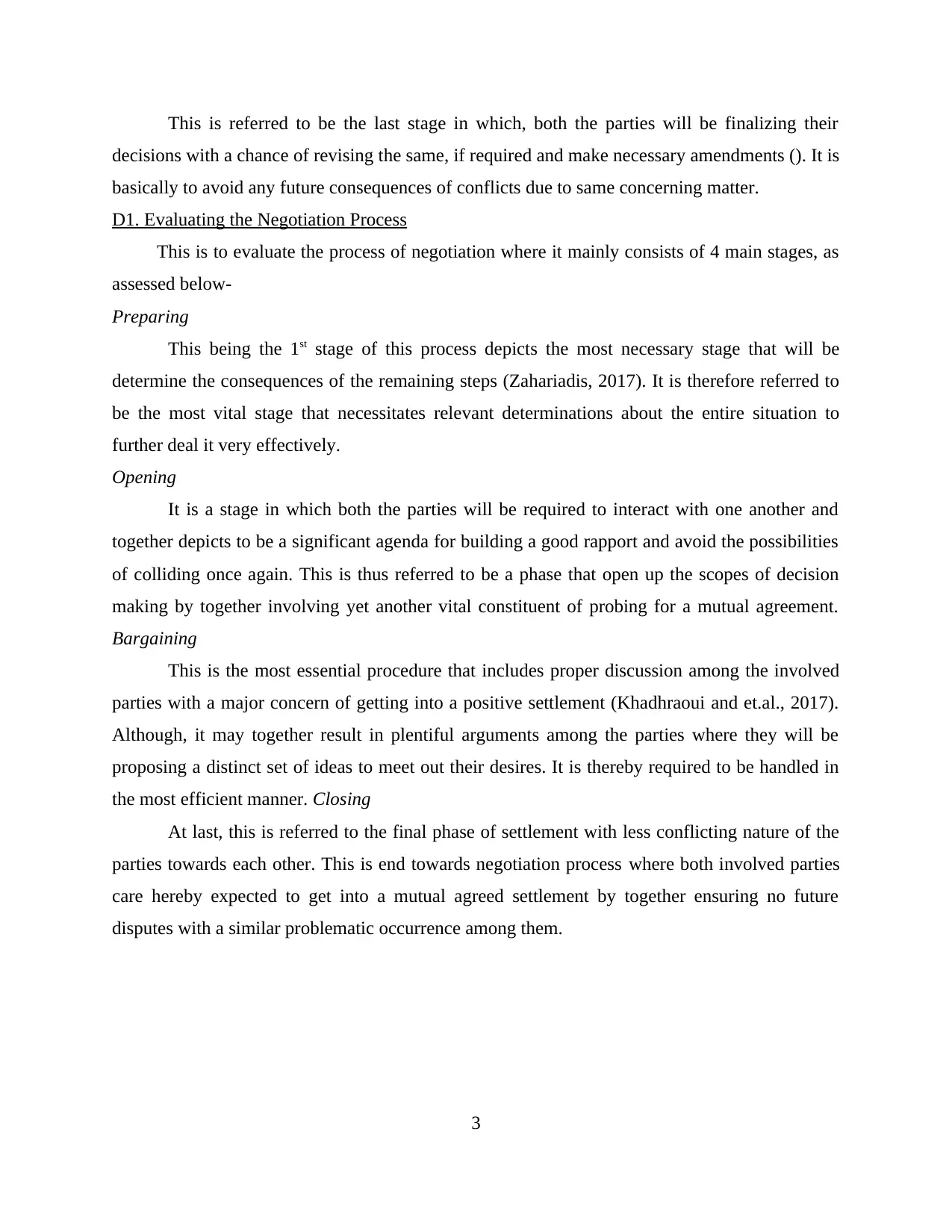
This is referred to be the last stage in which, both the parties will be finalizing their
decisions with a chance of revising the same, if required and make necessary amendments (). It is
basically to avoid any future consequences of conflicts due to same concerning matter.
D1. Evaluating the Negotiation Process
This is to evaluate the process of negotiation where it mainly consists of 4 main stages, as
assessed below-
Preparing
This being the 1st stage of this process depicts the most necessary stage that will be
determine the consequences of the remaining steps (Zahariadis, 2017). It is therefore referred to
be the most vital stage that necessitates relevant determinations about the entire situation to
further deal it very effectively.
Opening
It is a stage in which both the parties will be required to interact with one another and
together depicts to be a significant agenda for building a good rapport and avoid the possibilities
of colliding once again. This is thus referred to be a phase that open up the scopes of decision
making by together involving yet another vital constituent of probing for a mutual agreement.
Bargaining
This is the most essential procedure that includes proper discussion among the involved
parties with a major concern of getting into a positive settlement (Khadhraoui and et.al., 2017).
Although, it may together result in plentiful arguments among the parties where they will be
proposing a distinct set of ideas to meet out their desires. It is thereby required to be handled in
the most efficient manner. Closing
At last, this is referred to the final phase of settlement with less conflicting nature of the
parties towards each other. This is end towards negotiation process where both involved parties
care hereby expected to get into a mutual agreed settlement by together ensuring no future
disputes with a similar problematic occurrence among them.
3
decisions with a chance of revising the same, if required and make necessary amendments (). It is
basically to avoid any future consequences of conflicts due to same concerning matter.
D1. Evaluating the Negotiation Process
This is to evaluate the process of negotiation where it mainly consists of 4 main stages, as
assessed below-
Preparing
This being the 1st stage of this process depicts the most necessary stage that will be
determine the consequences of the remaining steps (Zahariadis, 2017). It is therefore referred to
be the most vital stage that necessitates relevant determinations about the entire situation to
further deal it very effectively.
Opening
It is a stage in which both the parties will be required to interact with one another and
together depicts to be a significant agenda for building a good rapport and avoid the possibilities
of colliding once again. This is thus referred to be a phase that open up the scopes of decision
making by together involving yet another vital constituent of probing for a mutual agreement.
Bargaining
This is the most essential procedure that includes proper discussion among the involved
parties with a major concern of getting into a positive settlement (Khadhraoui and et.al., 2017).
Although, it may together result in plentiful arguments among the parties where they will be
proposing a distinct set of ideas to meet out their desires. It is thereby required to be handled in
the most efficient manner. Closing
At last, this is referred to the final phase of settlement with less conflicting nature of the
parties towards each other. This is end towards negotiation process where both involved parties
care hereby expected to get into a mutual agreed settlement by together ensuring no future
disputes with a similar problematic occurrence among them.
3
⊘ This is a preview!⊘
Do you want full access?
Subscribe today to unlock all pages.

Trusted by 1+ million students worldwide
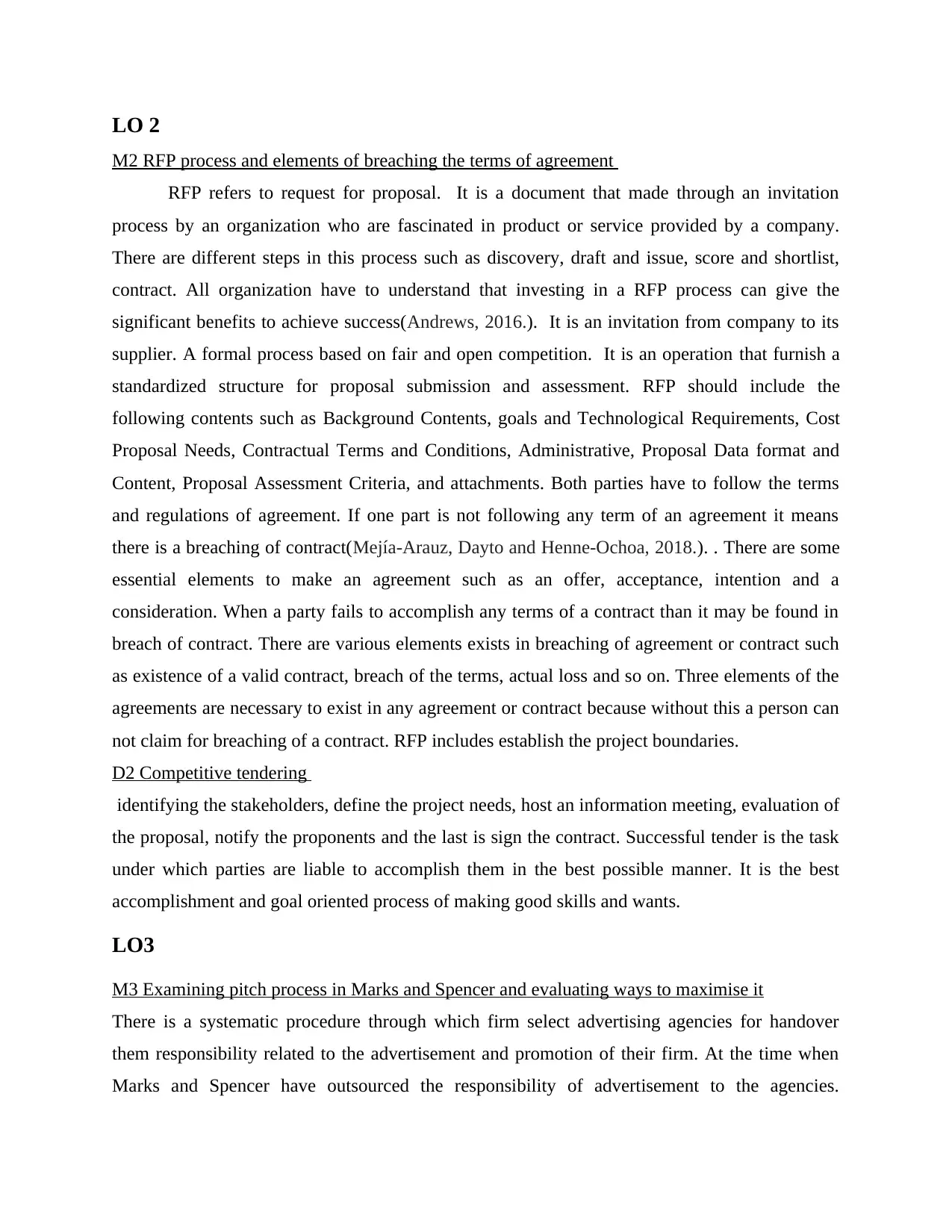
LO 2
M2 RFP process and elements of breaching the terms of agreement
RFP refers to request for proposal. It is a document that made through an invitation
process by an organization who are fascinated in product or service provided by a company.
There are different steps in this process such as discovery, draft and issue, score and shortlist,
contract. All organization have to understand that investing in a RFP process can give the
significant benefits to achieve success(Andrews, 2016.). It is an invitation from company to its
supplier. A formal process based on fair and open competition. It is an operation that furnish a
standardized structure for proposal submission and assessment. RFP should include the
following contents such as Background Contents, goals and Technological Requirements, Cost
Proposal Needs, Contractual Terms and Conditions, Administrative, Proposal Data format and
Content, Proposal Assessment Criteria, and attachments. Both parties have to follow the terms
and regulations of agreement. If one part is not following any term of an agreement it means
there is a breaching of contract(Mejía-Arauz, Dayto and Henne-Ochoa, 2018.). . There are some
essential elements to make an agreement such as an offer, acceptance, intention and a
consideration. When a party fails to accomplish any terms of a contract than it may be found in
breach of contract. There are various elements exists in breaching of agreement or contract such
as existence of a valid contract, breach of the terms, actual loss and so on. Three elements of the
agreements are necessary to exist in any agreement or contract because without this a person can
not claim for breaching of a contract. RFP includes establish the project boundaries.
D2 Competitive tendering
identifying the stakeholders, define the project needs, host an information meeting, evaluation of
the proposal, notify the proponents and the last is sign the contract. Successful tender is the task
under which parties are liable to accomplish them in the best possible manner. It is the best
accomplishment and goal oriented process of making good skills and wants.
LO3
M3 Examining pitch process in Marks and Spencer and evaluating ways to maximise it
There is a systematic procedure through which firm select advertising agencies for handover
them responsibility related to the advertisement and promotion of their firm. At the time when
Marks and Spencer have outsourced the responsibility of advertisement to the agencies.
M2 RFP process and elements of breaching the terms of agreement
RFP refers to request for proposal. It is a document that made through an invitation
process by an organization who are fascinated in product or service provided by a company.
There are different steps in this process such as discovery, draft and issue, score and shortlist,
contract. All organization have to understand that investing in a RFP process can give the
significant benefits to achieve success(Andrews, 2016.). It is an invitation from company to its
supplier. A formal process based on fair and open competition. It is an operation that furnish a
standardized structure for proposal submission and assessment. RFP should include the
following contents such as Background Contents, goals and Technological Requirements, Cost
Proposal Needs, Contractual Terms and Conditions, Administrative, Proposal Data format and
Content, Proposal Assessment Criteria, and attachments. Both parties have to follow the terms
and regulations of agreement. If one part is not following any term of an agreement it means
there is a breaching of contract(Mejía-Arauz, Dayto and Henne-Ochoa, 2018.). . There are some
essential elements to make an agreement such as an offer, acceptance, intention and a
consideration. When a party fails to accomplish any terms of a contract than it may be found in
breach of contract. There are various elements exists in breaching of agreement or contract such
as existence of a valid contract, breach of the terms, actual loss and so on. Three elements of the
agreements are necessary to exist in any agreement or contract because without this a person can
not claim for breaching of a contract. RFP includes establish the project boundaries.
D2 Competitive tendering
identifying the stakeholders, define the project needs, host an information meeting, evaluation of
the proposal, notify the proponents and the last is sign the contract. Successful tender is the task
under which parties are liable to accomplish them in the best possible manner. It is the best
accomplishment and goal oriented process of making good skills and wants.
LO3
M3 Examining pitch process in Marks and Spencer and evaluating ways to maximise it
There is a systematic procedure through which firm select advertising agencies for handover
them responsibility related to the advertisement and promotion of their firm. At the time when
Marks and Spencer have outsourced the responsibility of advertisement to the agencies.
Paraphrase This Document
Need a fresh take? Get an instant paraphrase of this document with our AI Paraphraser
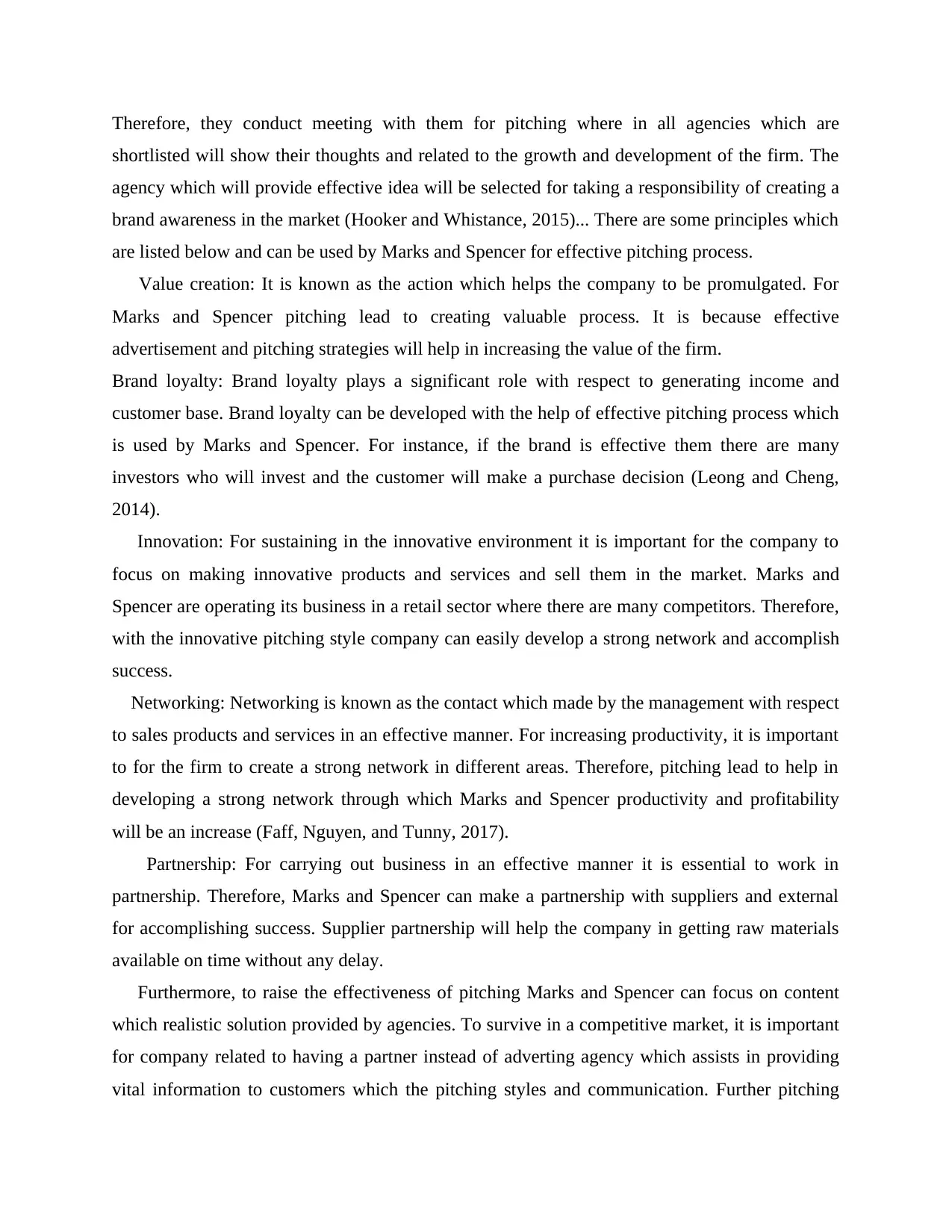
Therefore, they conduct meeting with them for pitching where in all agencies which are
shortlisted will show their thoughts and related to the growth and development of the firm. The
agency which will provide effective idea will be selected for taking a responsibility of creating a
brand awareness in the market (Hooker and Whistance, 2015)... There are some principles which
are listed below and can be used by Marks and Spencer for effective pitching process.
Value creation: It is known as the action which helps the company to be promulgated. For
Marks and Spencer pitching lead to creating valuable process. It is because effective
advertisement and pitching strategies will help in increasing the value of the firm.
Brand loyalty: Brand loyalty plays a significant role with respect to generating income and
customer base. Brand loyalty can be developed with the help of effective pitching process which
is used by Marks and Spencer. For instance, if the brand is effective them there are many
investors who will invest and the customer will make a purchase decision (Leong and Cheng,
2014).
Innovation: For sustaining in the innovative environment it is important for the company to
focus on making innovative products and services and sell them in the market. Marks and
Spencer are operating its business in a retail sector where there are many competitors. Therefore,
with the innovative pitching style company can easily develop a strong network and accomplish
success.
Networking: Networking is known as the contact which made by the management with respect
to sales products and services in an effective manner. For increasing productivity, it is important
to for the firm to create a strong network in different areas. Therefore, pitching lead to help in
developing a strong network through which Marks and Spencer productivity and profitability
will be an increase (Faff, Nguyen, and Tunny, 2017).
Partnership: For carrying out business in an effective manner it is essential to work in
partnership. Therefore, Marks and Spencer can make a partnership with suppliers and external
for accomplishing success. Supplier partnership will help the company in getting raw materials
available on time without any delay.
Furthermore, to raise the effectiveness of pitching Marks and Spencer can focus on content
which realistic solution provided by agencies. To survive in a competitive market, it is important
for company related to having a partner instead of adverting agency which assists in providing
vital information to customers which the pitching styles and communication. Further pitching
shortlisted will show their thoughts and related to the growth and development of the firm. The
agency which will provide effective idea will be selected for taking a responsibility of creating a
brand awareness in the market (Hooker and Whistance, 2015)... There are some principles which
are listed below and can be used by Marks and Spencer for effective pitching process.
Value creation: It is known as the action which helps the company to be promulgated. For
Marks and Spencer pitching lead to creating valuable process. It is because effective
advertisement and pitching strategies will help in increasing the value of the firm.
Brand loyalty: Brand loyalty plays a significant role with respect to generating income and
customer base. Brand loyalty can be developed with the help of effective pitching process which
is used by Marks and Spencer. For instance, if the brand is effective them there are many
investors who will invest and the customer will make a purchase decision (Leong and Cheng,
2014).
Innovation: For sustaining in the innovative environment it is important for the company to
focus on making innovative products and services and sell them in the market. Marks and
Spencer are operating its business in a retail sector where there are many competitors. Therefore,
with the innovative pitching style company can easily develop a strong network and accomplish
success.
Networking: Networking is known as the contact which made by the management with respect
to sales products and services in an effective manner. For increasing productivity, it is important
to for the firm to create a strong network in different areas. Therefore, pitching lead to help in
developing a strong network through which Marks and Spencer productivity and profitability
will be an increase (Faff, Nguyen, and Tunny, 2017).
Partnership: For carrying out business in an effective manner it is essential to work in
partnership. Therefore, Marks and Spencer can make a partnership with suppliers and external
for accomplishing success. Supplier partnership will help the company in getting raw materials
available on time without any delay.
Furthermore, to raise the effectiveness of pitching Marks and Spencer can focus on content
which realistic solution provided by agencies. To survive in a competitive market, it is important
for company related to having a partner instead of adverting agency which assists in providing
vital information to customers which the pitching styles and communication. Further pitching
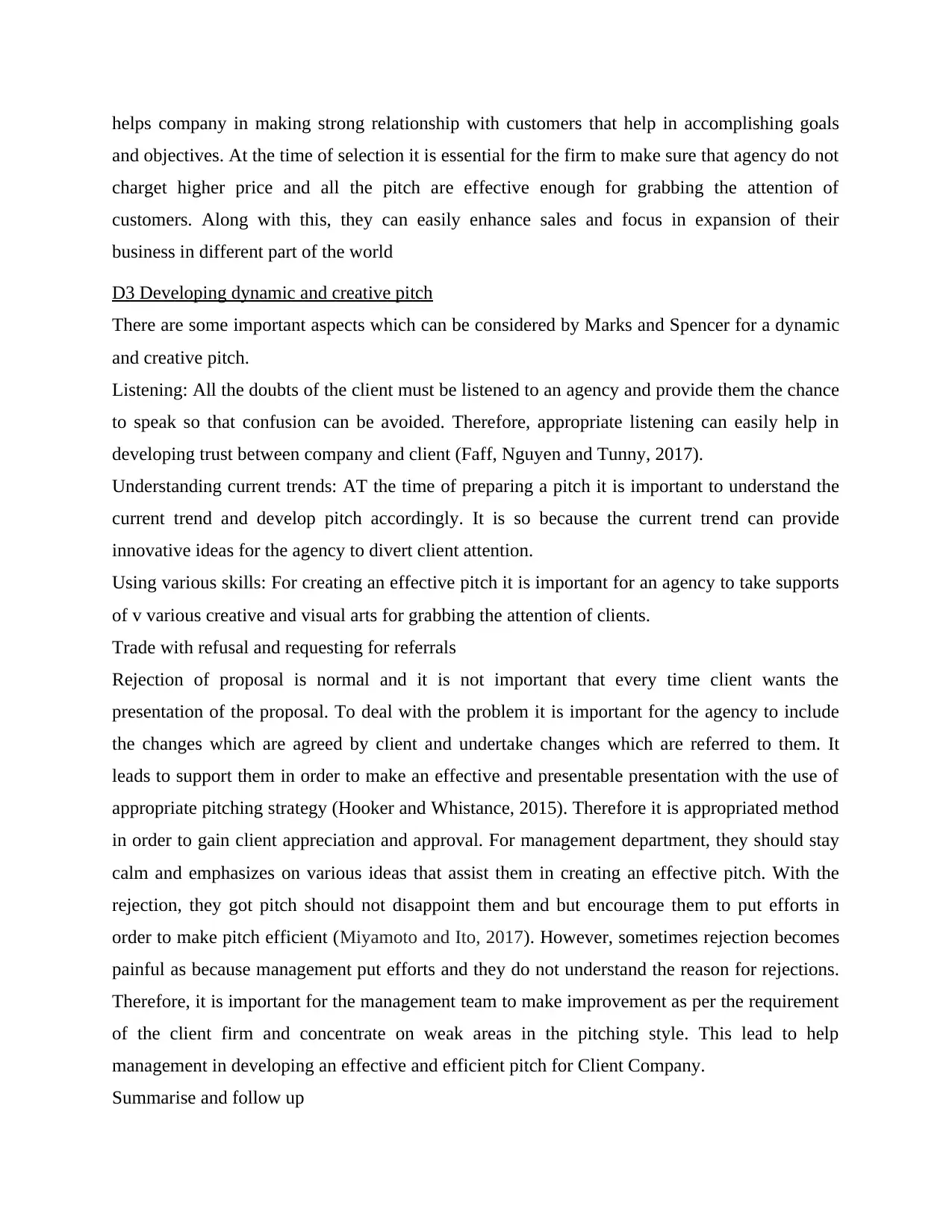
helps company in making strong relationship with customers that help in accomplishing goals
and objectives. At the time of selection it is essential for the firm to make sure that agency do not
charget higher price and all the pitch are effective enough for grabbing the attention of
customers. Along with this, they can easily enhance sales and focus in expansion of their
business in different part of the world
D3 Developing dynamic and creative pitch
There are some important aspects which can be considered by Marks and Spencer for a dynamic
and creative pitch.
Listening: All the doubts of the client must be listened to an agency and provide them the chance
to speak so that confusion can be avoided. Therefore, appropriate listening can easily help in
developing trust between company and client (Faff, Nguyen and Tunny, 2017).
Understanding current trends: AT the time of preparing a pitch it is important to understand the
current trend and develop pitch accordingly. It is so because the current trend can provide
innovative ideas for the agency to divert client attention.
Using various skills: For creating an effective pitch it is important for an agency to take supports
of v various creative and visual arts for grabbing the attention of clients.
Trade with refusal and requesting for referrals
Rejection of proposal is normal and it is not important that every time client wants the
presentation of the proposal. To deal with the problem it is important for the agency to include
the changes which are agreed by client and undertake changes which are referred to them. It
leads to support them in order to make an effective and presentable presentation with the use of
appropriate pitching strategy (Hooker and Whistance, 2015). Therefore it is appropriated method
in order to gain client appreciation and approval. For management department, they should stay
calm and emphasizes on various ideas that assist them in creating an effective pitch. With the
rejection, they got pitch should not disappoint them and but encourage them to put efforts in
order to make pitch efficient (Miyamoto and Ito, 2017). However, sometimes rejection becomes
painful as because management put efforts and they do not understand the reason for rejections.
Therefore, it is important for the management team to make improvement as per the requirement
of the client firm and concentrate on weak areas in the pitching style. This lead to help
management in developing an effective and efficient pitch for Client Company.
Summarise and follow up
and objectives. At the time of selection it is essential for the firm to make sure that agency do not
charget higher price and all the pitch are effective enough for grabbing the attention of
customers. Along with this, they can easily enhance sales and focus in expansion of their
business in different part of the world
D3 Developing dynamic and creative pitch
There are some important aspects which can be considered by Marks and Spencer for a dynamic
and creative pitch.
Listening: All the doubts of the client must be listened to an agency and provide them the chance
to speak so that confusion can be avoided. Therefore, appropriate listening can easily help in
developing trust between company and client (Faff, Nguyen and Tunny, 2017).
Understanding current trends: AT the time of preparing a pitch it is important to understand the
current trend and develop pitch accordingly. It is so because the current trend can provide
innovative ideas for the agency to divert client attention.
Using various skills: For creating an effective pitch it is important for an agency to take supports
of v various creative and visual arts for grabbing the attention of clients.
Trade with refusal and requesting for referrals
Rejection of proposal is normal and it is not important that every time client wants the
presentation of the proposal. To deal with the problem it is important for the agency to include
the changes which are agreed by client and undertake changes which are referred to them. It
leads to support them in order to make an effective and presentable presentation with the use of
appropriate pitching strategy (Hooker and Whistance, 2015). Therefore it is appropriated method
in order to gain client appreciation and approval. For management department, they should stay
calm and emphasizes on various ideas that assist them in creating an effective pitch. With the
rejection, they got pitch should not disappoint them and but encourage them to put efforts in
order to make pitch efficient (Miyamoto and Ito, 2017). However, sometimes rejection becomes
painful as because management put efforts and they do not understand the reason for rejections.
Therefore, it is important for the management team to make improvement as per the requirement
of the client firm and concentrate on weak areas in the pitching style. This lead to help
management in developing an effective and efficient pitch for Client Company.
Summarise and follow up
⊘ This is a preview!⊘
Do you want full access?
Subscribe today to unlock all pages.

Trusted by 1+ million students worldwide
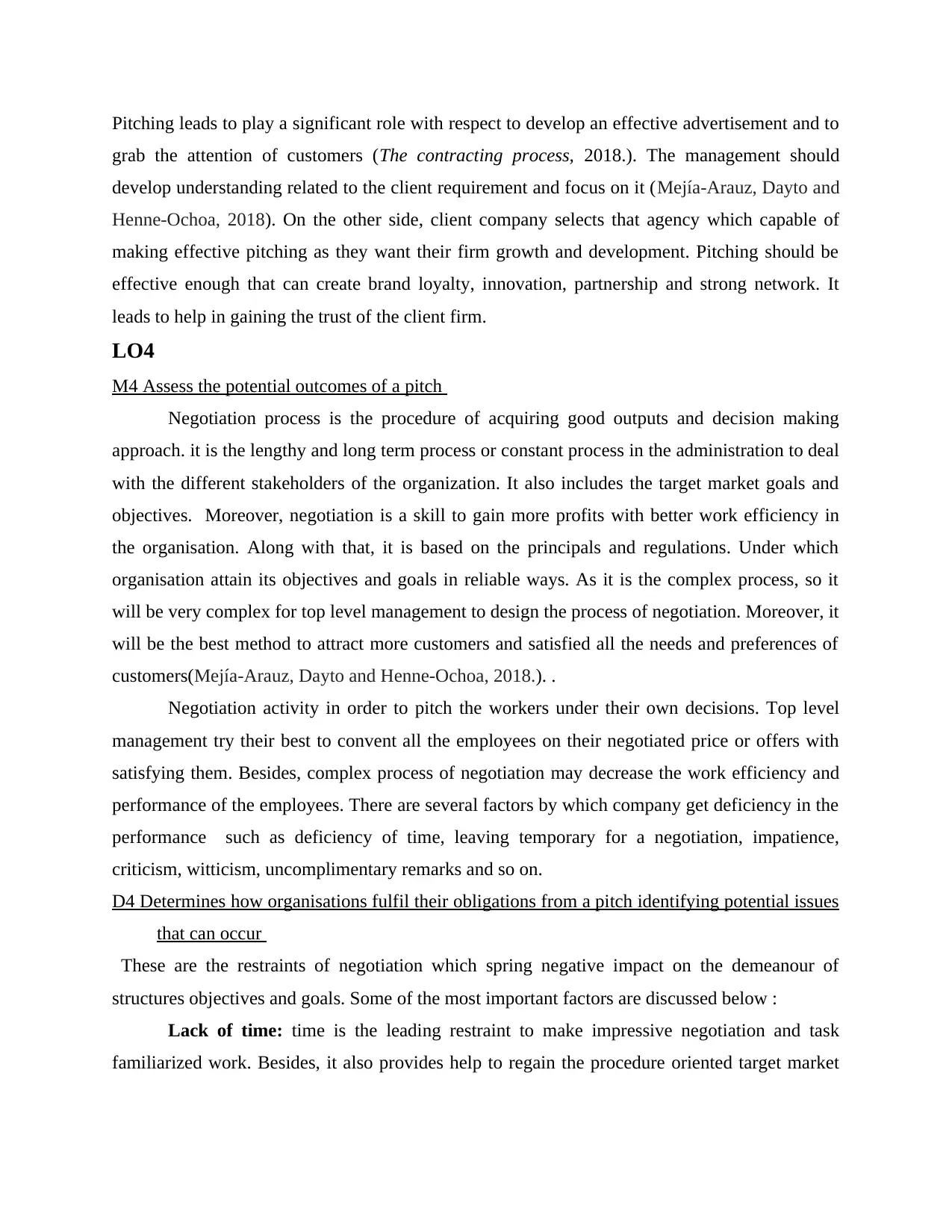
Pitching leads to play a significant role with respect to develop an effective advertisement and to
grab the attention of customers (The contracting process, 2018.). The management should
develop understanding related to the client requirement and focus on it (Mejía-Arauz, Dayto and
Henne-Ochoa, 2018). On the other side, client company selects that agency which capable of
making effective pitching as they want their firm growth and development. Pitching should be
effective enough that can create brand loyalty, innovation, partnership and strong network. It
leads to help in gaining the trust of the client firm.
LO4
M4 Assess the potential outcomes of a pitch
Negotiation process is the procedure of acquiring good outputs and decision making
approach. it is the lengthy and long term process or constant process in the administration to deal
with the different stakeholders of the organization. It also includes the target market goals and
objectives. Moreover, negotiation is a skill to gain more profits with better work efficiency in
the organisation. Along with that, it is based on the principals and regulations. Under which
organisation attain its objectives and goals in reliable ways. As it is the complex process, so it
will be very complex for top level management to design the process of negotiation. Moreover, it
will be the best method to attract more customers and satisfied all the needs and preferences of
customers(Mejía-Arauz, Dayto and Henne-Ochoa, 2018.). .
Negotiation activity in order to pitch the workers under their own decisions. Top level
management try their best to convent all the employees on their negotiated price or offers with
satisfying them. Besides, complex process of negotiation may decrease the work efficiency and
performance of the employees. There are several factors by which company get deficiency in the
performance such as deficiency of time, leaving temporary for a negotiation, impatience,
criticism, witticism, uncomplimentary remarks and so on.
D4 Determines how organisations fulfil their obligations from a pitch identifying potential issues
that can occur
These are the restraints of negotiation which spring negative impact on the demeanour of
structures objectives and goals. Some of the most important factors are discussed below :
Lack of time: time is the leading restraint to make impressive negotiation and task
familiarized work. Besides, it also provides help to regain the procedure oriented target market
grab the attention of customers (The contracting process, 2018.). The management should
develop understanding related to the client requirement and focus on it (Mejía-Arauz, Dayto and
Henne-Ochoa, 2018). On the other side, client company selects that agency which capable of
making effective pitching as they want their firm growth and development. Pitching should be
effective enough that can create brand loyalty, innovation, partnership and strong network. It
leads to help in gaining the trust of the client firm.
LO4
M4 Assess the potential outcomes of a pitch
Negotiation process is the procedure of acquiring good outputs and decision making
approach. it is the lengthy and long term process or constant process in the administration to deal
with the different stakeholders of the organization. It also includes the target market goals and
objectives. Moreover, negotiation is a skill to gain more profits with better work efficiency in
the organisation. Along with that, it is based on the principals and regulations. Under which
organisation attain its objectives and goals in reliable ways. As it is the complex process, so it
will be very complex for top level management to design the process of negotiation. Moreover, it
will be the best method to attract more customers and satisfied all the needs and preferences of
customers(Mejía-Arauz, Dayto and Henne-Ochoa, 2018.). .
Negotiation activity in order to pitch the workers under their own decisions. Top level
management try their best to convent all the employees on their negotiated price or offers with
satisfying them. Besides, complex process of negotiation may decrease the work efficiency and
performance of the employees. There are several factors by which company get deficiency in the
performance such as deficiency of time, leaving temporary for a negotiation, impatience,
criticism, witticism, uncomplimentary remarks and so on.
D4 Determines how organisations fulfil their obligations from a pitch identifying potential issues
that can occur
These are the restraints of negotiation which spring negative impact on the demeanour of
structures objectives and goals. Some of the most important factors are discussed below :
Lack of time: time is the leading restraint to make impressive negotiation and task
familiarized work. Besides, it also provides help to regain the procedure oriented target market
Paraphrase This Document
Need a fresh take? Get an instant paraphrase of this document with our AI Paraphraser
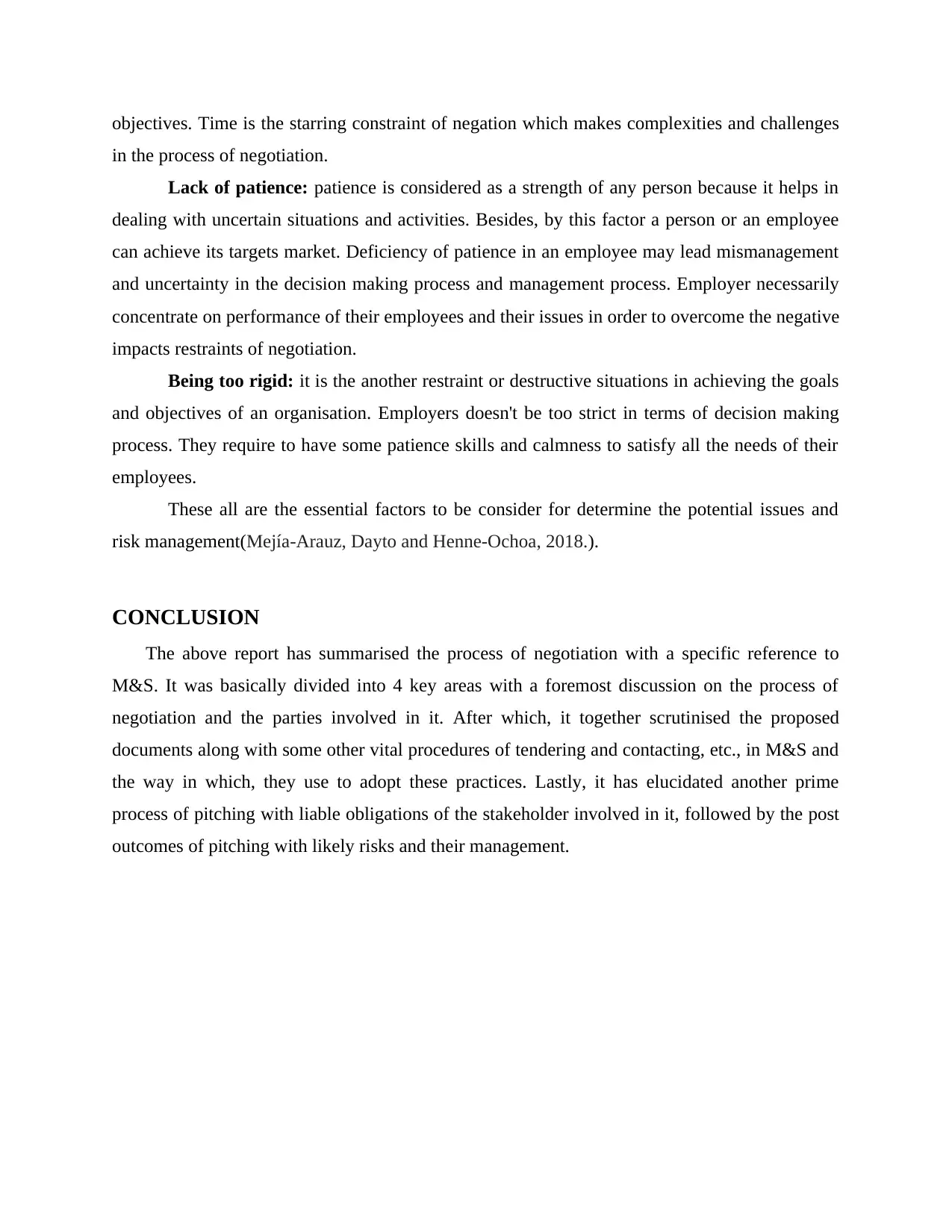
objectives. Time is the starring constraint of negation which makes complexities and challenges
in the process of negotiation.
Lack of patience: patience is considered as a strength of any person because it helps in
dealing with uncertain situations and activities. Besides, by this factor a person or an employee
can achieve its targets market. Deficiency of patience in an employee may lead mismanagement
and uncertainty in the decision making process and management process. Employer necessarily
concentrate on performance of their employees and their issues in order to overcome the negative
impacts restraints of negotiation.
Being too rigid: it is the another restraint or destructive situations in achieving the goals
and objectives of an organisation. Employers doesn't be too strict in terms of decision making
process. They require to have some patience skills and calmness to satisfy all the needs of their
employees.
These all are the essential factors to be consider for determine the potential issues and
risk management(Mejía-Arauz, Dayto and Henne-Ochoa, 2018.).
CONCLUSION
The above report has summarised the process of negotiation with a specific reference to
M&S. It was basically divided into 4 key areas with a foremost discussion on the process of
negotiation and the parties involved in it. After which, it together scrutinised the proposed
documents along with some other vital procedures of tendering and contacting, etc., in M&S and
the way in which, they use to adopt these practices. Lastly, it has elucidated another prime
process of pitching with liable obligations of the stakeholder involved in it, followed by the post
outcomes of pitching with likely risks and their management.
in the process of negotiation.
Lack of patience: patience is considered as a strength of any person because it helps in
dealing with uncertain situations and activities. Besides, by this factor a person or an employee
can achieve its targets market. Deficiency of patience in an employee may lead mismanagement
and uncertainty in the decision making process and management process. Employer necessarily
concentrate on performance of their employees and their issues in order to overcome the negative
impacts restraints of negotiation.
Being too rigid: it is the another restraint or destructive situations in achieving the goals
and objectives of an organisation. Employers doesn't be too strict in terms of decision making
process. They require to have some patience skills and calmness to satisfy all the needs of their
employees.
These all are the essential factors to be consider for determine the potential issues and
risk management(Mejía-Arauz, Dayto and Henne-Ochoa, 2018.).
CONCLUSION
The above report has summarised the process of negotiation with a specific reference to
M&S. It was basically divided into 4 key areas with a foremost discussion on the process of
negotiation and the parties involved in it. After which, it together scrutinised the proposed
documents along with some other vital procedures of tendering and contacting, etc., in M&S and
the way in which, they use to adopt these practices. Lastly, it has elucidated another prime
process of pitching with liable obligations of the stakeholder involved in it, followed by the post
outcomes of pitching with likely risks and their management.
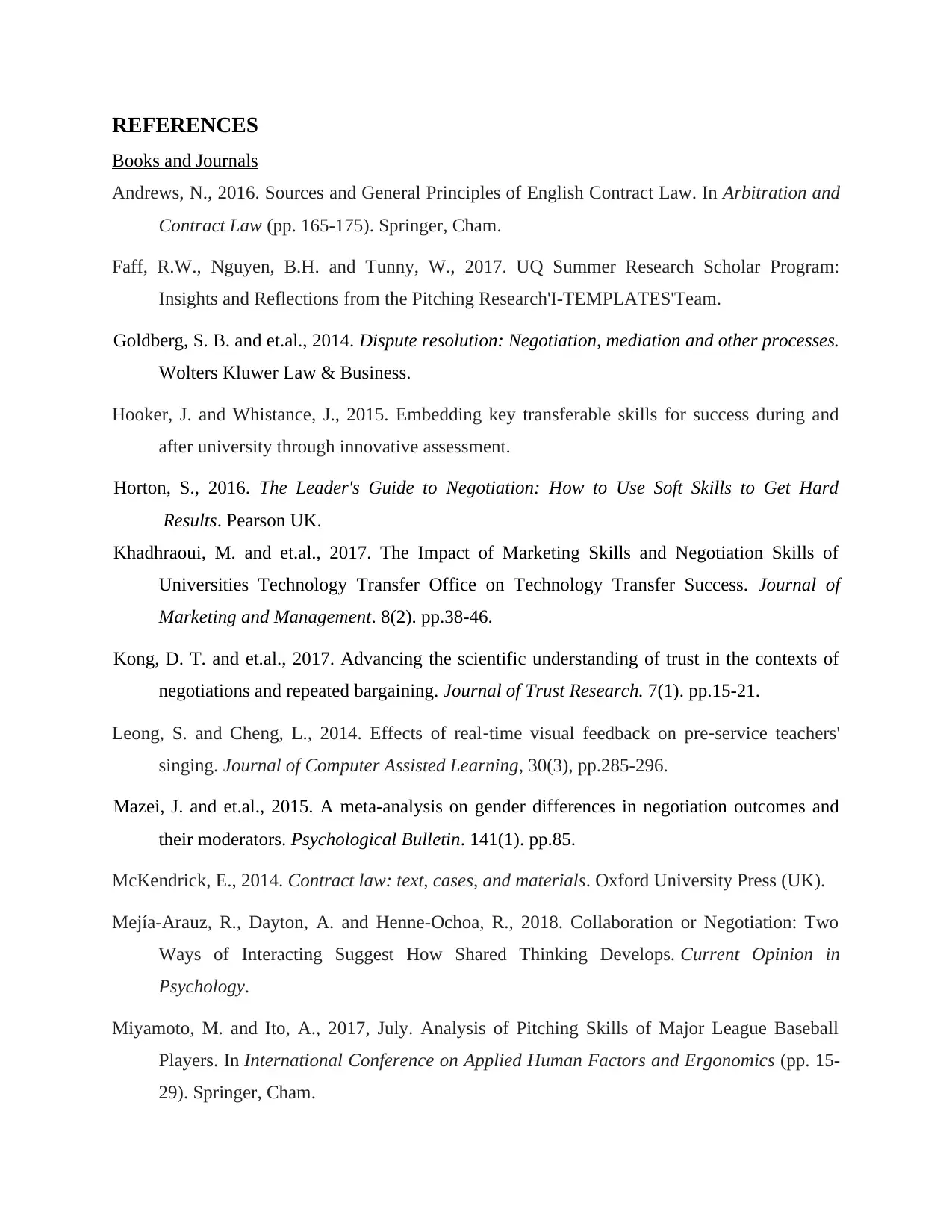
REFERENCES
Books and Journals
Andrews, N., 2016. Sources and General Principles of English Contract Law. In Arbitration and
Contract Law (pp. 165-175). Springer, Cham.
Faff, R.W., Nguyen, B.H. and Tunny, W., 2017. UQ Summer Research Scholar Program:
Insights and Reflections from the Pitching Research'I-TEMPLATES'Team.
Goldberg, S. B. and et.al., 2014. Dispute resolution: Negotiation, mediation and other processes.
Wolters Kluwer Law & Business.
Hooker, J. and Whistance, J., 2015. Embedding key transferable skills for success during and
after university through innovative assessment.
Horton, S., 2016. The Leader's Guide to Negotiation: How to Use Soft Skills to Get Hard
Results. Pearson UK.
Khadhraoui, M. and et.al., 2017. The Impact of Marketing Skills and Negotiation Skills of
Universities Technology Transfer Office on Technology Transfer Success. Journal of
Marketing and Management. 8(2). pp.38-46.
Kong, D. T. and et.al., 2017. Advancing the scientific understanding of trust in the contexts of
negotiations and repeated bargaining. Journal of Trust Research. 7(1). pp.15-21.
Leong, S. and Cheng, L., 2014. Effects of real‐time visual feedback on pre‐service teachers'
singing. Journal of Computer Assisted Learning, 30(3), pp.285-296.
Mazei, J. and et.al., 2015. A meta-analysis on gender differences in negotiation outcomes and
their moderators. Psychological Bulletin. 141(1). pp.85.
McKendrick, E., 2014. Contract law: text, cases, and materials. Oxford University Press (UK).
Mejía-Arauz, R., Dayton, A. and Henne-Ochoa, R., 2018. Collaboration or Negotiation: Two
Ways of Interacting Suggest How Shared Thinking Develops. Current Opinion in
Psychology.
Miyamoto, M. and Ito, A., 2017, July. Analysis of Pitching Skills of Major League Baseball
Players. In International Conference on Applied Human Factors and Ergonomics (pp. 15-
29). Springer, Cham.
Books and Journals
Andrews, N., 2016. Sources and General Principles of English Contract Law. In Arbitration and
Contract Law (pp. 165-175). Springer, Cham.
Faff, R.W., Nguyen, B.H. and Tunny, W., 2017. UQ Summer Research Scholar Program:
Insights and Reflections from the Pitching Research'I-TEMPLATES'Team.
Goldberg, S. B. and et.al., 2014. Dispute resolution: Negotiation, mediation and other processes.
Wolters Kluwer Law & Business.
Hooker, J. and Whistance, J., 2015. Embedding key transferable skills for success during and
after university through innovative assessment.
Horton, S., 2016. The Leader's Guide to Negotiation: How to Use Soft Skills to Get Hard
Results. Pearson UK.
Khadhraoui, M. and et.al., 2017. The Impact of Marketing Skills and Negotiation Skills of
Universities Technology Transfer Office on Technology Transfer Success. Journal of
Marketing and Management. 8(2). pp.38-46.
Kong, D. T. and et.al., 2017. Advancing the scientific understanding of trust in the contexts of
negotiations and repeated bargaining. Journal of Trust Research. 7(1). pp.15-21.
Leong, S. and Cheng, L., 2014. Effects of real‐time visual feedback on pre‐service teachers'
singing. Journal of Computer Assisted Learning, 30(3), pp.285-296.
Mazei, J. and et.al., 2015. A meta-analysis on gender differences in negotiation outcomes and
their moderators. Psychological Bulletin. 141(1). pp.85.
McKendrick, E., 2014. Contract law: text, cases, and materials. Oxford University Press (UK).
Mejía-Arauz, R., Dayton, A. and Henne-Ochoa, R., 2018. Collaboration or Negotiation: Two
Ways of Interacting Suggest How Shared Thinking Develops. Current Opinion in
Psychology.
Miyamoto, M. and Ito, A., 2017, July. Analysis of Pitching Skills of Major League Baseball
Players. In International Conference on Applied Human Factors and Ergonomics (pp. 15-
29). Springer, Cham.
⊘ This is a preview!⊘
Do you want full access?
Subscribe today to unlock all pages.

Trusted by 1+ million students worldwide
1 out of 13
Related Documents
Your All-in-One AI-Powered Toolkit for Academic Success.
+13062052269
info@desklib.com
Available 24*7 on WhatsApp / Email
![[object Object]](/_next/static/media/star-bottom.7253800d.svg)
Unlock your academic potential
Copyright © 2020–2025 A2Z Services. All Rights Reserved. Developed and managed by ZUCOL.





